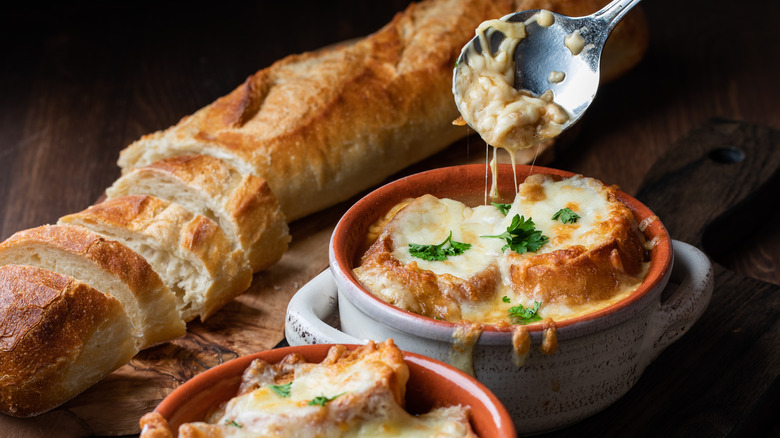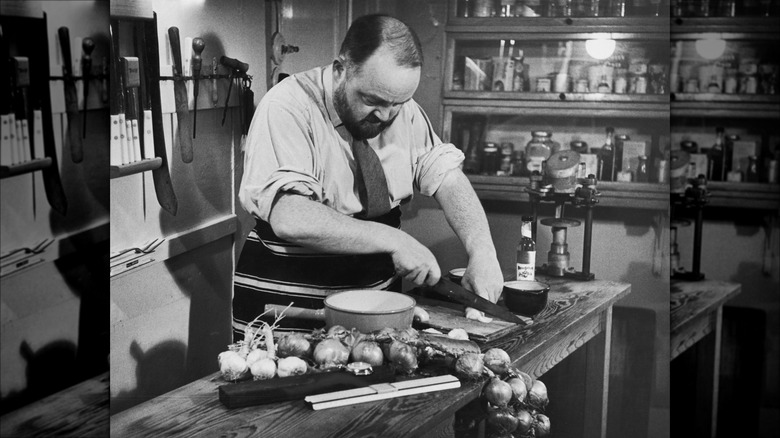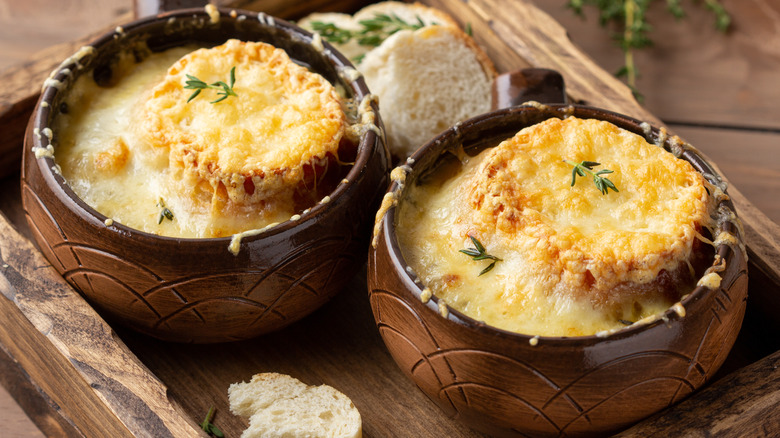What Type Of Cheese Usually Tops French Onion Soup?
The unmistakable aroma of onion fills kitchens around the globe, as it accents the best of local and far-flung fare, but no dish celebrates this humble ingredient like a satisfying bowl of French onion soup. The caramelized onions and savory beef broth deliver warmth to your taste buds as the soup settles you into a state of bliss. Of course, this classic French cuisine isn't complete without two other essential elements: a crispy slice off a French loaf and Gruyère cheese melted to perfection.
With its nutty creaminess offering just enough flavor to excite the palette but not overwhelm it, Gruyère excels at enhancing dips, quiches, and cheesy baked goods. French onion soup without a generous portion of perfectly melted Gruyère is like a sundae without a cherry on top; it's the key component that identifies this classic dish and has been for some time. Some say the soup originated in the 18th century; others contend that the version we know today wasn't around until the early 20th century. But the truth is, versions of this classic dish have been around much longer than either of these theories propose.
The origins of a classic comfort food
One theory suggests that King Louis XV once found his cupboards bare except for some onions, butter, and champagne. Famished as he was after a hunt, he combined these ingredients and happened upon an early recipe for French onion soup that became popular among the wealthy. Another story stipulates that the Duke of Lorraine, Stanislas Leszczynski, was so impressed with the cuisine after trying it on a trip to the Champagne region of France that he studied the chefs who prepared it. Confident he had mastered the recipe, he returned home and began making the dish to impress others with his culinary skills.
While intriguing stories, the origins of French onion soup go back much further than either of these accounts. Basic onion soups have existed for millennia and were a culinary staple in ancient Roman culture. A 14th-century cookbook called "Viandier "showcased an early version of French onion soup made with onions, butter, and pea puree.
The components of the dish had long been staples in soups for poorer classes. By the 19th century, however, French restaurants started serving it with a crouton and the iconic broiler charred gratinée, and before long, French onion soup was adored by the affluent and underprivileged alike. Laborers ate the soup before or after a long shift, and the well-off commonly enjoyed it after a wild night of indulgence.
How to melt the cheese properly
Gruyère is just as much a part of the identity of this classic French flavor as the onions, but getting it to soften correctly over the top of the crouton can be tricky. Once your soup is ready, ladle some into a croquette or a small oven-safe bowl and place your crouton atop the soup. Then, grate some Gruyère cheese over the crouton. Expertly melting the cheese will make or break a comforting French onion soup. The Gruyère should be thoroughly liquified, bubbly, and slightly crusty around the outer edge of the croquette. An ideal way to achieve this is to put the dish under a broiler for a few minutes. You need to monitor the cheese to ensure it doesn't burn, which can happen quickly.
However, if you prefer something more hands-on, melting the cheese with a kitchen torch is another great option. To do so, carefully direct the flame over the cheese evenly until it's gooey and golden brown. The caramelization you get from using a torch is a bonus that will add a depth of flavor to your soup. As long as the Gruyère is properly melted, however you go about doing so, it will be the chef's kiss to this storied classic.


